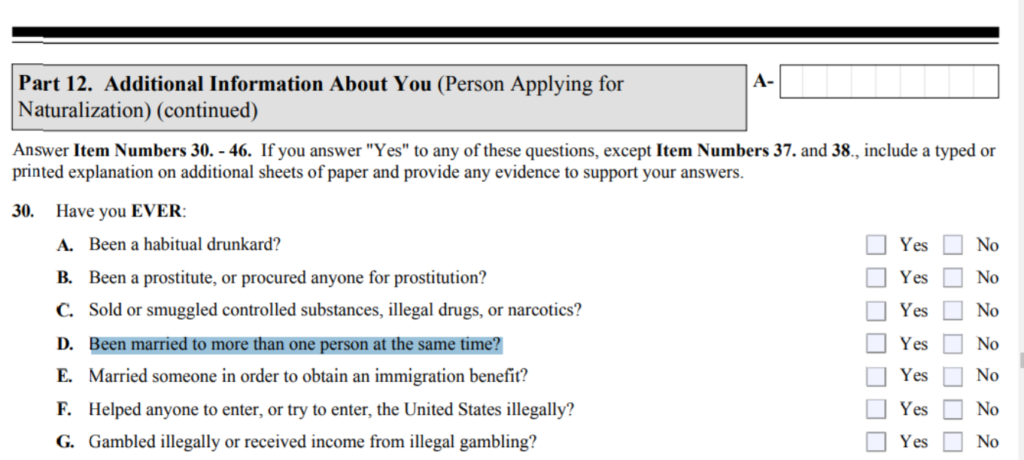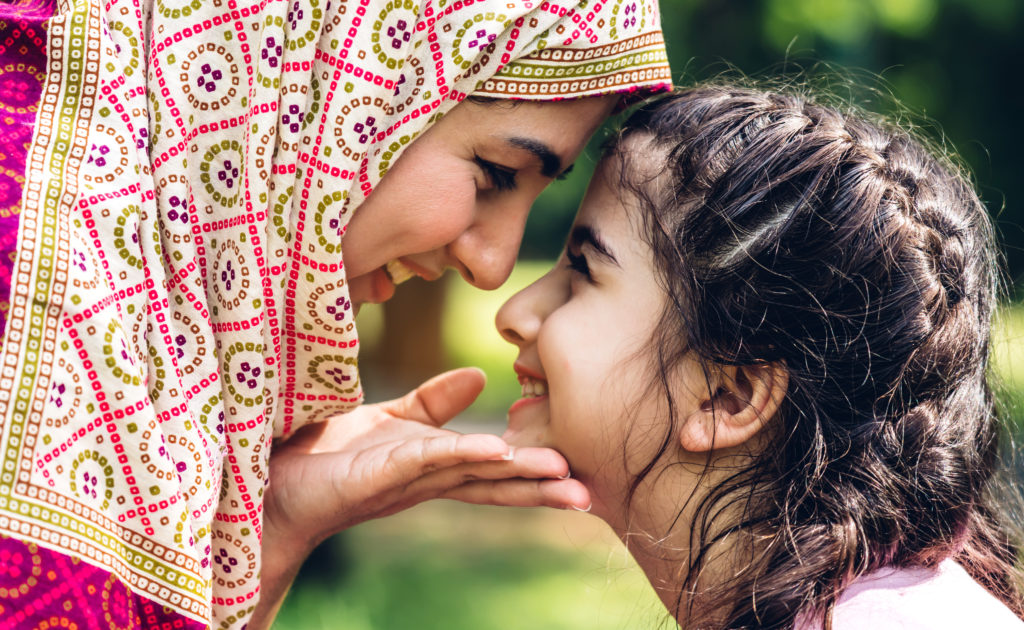
Immigration law has many quirky rules.
In some cases, this is because laws and customs in other countries do not match up with laws and customs in the United States.
Take polygamy.
Long condemned in the U.S., polygamy has been practiced in over 81% of societies across the world.
As a result, husbands and wives lawfully wedded abroad are often left behind when they seek permanent resident status.
What Is Bigamy?
Many folks confuse the meaning of bigamy with the meaning of polygamy.
Both terms refer to persons married to more than one person at the same time.
But there’s a difference.
Bigamy is narrower then polygamy.
Bigamy is the act of being intentionally married to more than one spouse at a time.
To commit bigamy, you first have to marry one person. Then marry a second person – without divorcing the first person.
This is usually done deceptively. Neither spouse knows the truth about the other one.
Intentional bigamy is a crime.

What Is Polygamy?
Polygamy, on the other hand, is the custom of having more than one spouse at the same time.
These are situations where all the parties to all the marriages are aware of the different relationships. They consent to the arrangement for cultural or religious reasons.
That seems like an easy distinction to understand.
Yet, immigration law does not stop there.
A “spouse” can be anyone whom an immigrant considers a spouse, even if they are not technically a spouse under U.S. law.
This means the immigrant, seeking to legalize their status in the U.S., does not need to be the person who has multiple partners to run afoul of immigration rules.
If the immigrant is merely one of the partners, immigration officials will still consider him to be practicing polygamy.
And these rules apply even if the partner, who is the one practicing polygamy, lives abroad.
Different Types Of Polygamy
There are three forms of polygamy:
- Polygyny is the practice of one man having multiple wives
- Polyandry is the practice of one woman having multiple husbands
- De Facto Polygamy is when men and women do not wed but have multiple partners
The commonality is that in each of these situations, individuals choose to share their lives together and create families.
In this article, even though the rules for polygamy apply equally to all forms, we’ll focus on polygyny for the sake of simplicity.
A Brief Explanation Of The Quirky
Bigamy – Polygamy Distinction
To reiterate, bigamy and polygamy are not synonymous terms. They have disparate immigration consequences, explained in the examples below.
A practicing polygamist might not be a bigamist. This happens if he does not attempt to legally marry more than one spouse at the same time.
Take, for example, a man who is legally married to only one woman, yet, on the basis of his cultural traditions, has formed a household with multiple women as “wives”. Since he is not legally married, he is not considered a bigamist.
A bigamist is not considered a polygamist under immigration law.
Bigamy occurs when a husband has engaged in marital ceremonies with more than one woman but pretends to be in a monogamous relationship with each of them.
Because he conceals the truth from his purported legal spouses, he does not meet the consensually shared relationship definition of a polygamist under immigration law.
This problem could arise in what is typically known as common law marriages. In some countries, it is not unusual for couples to live together in marital-type situations. When the immigrant later moves to the U.S. and is sponsored by a citizen for immigration benefits, allegations of bigamy often surface.
A Side Note: Concerns About Polygamy In Naturalization Applications
Let’s briefly look at citizenship applications and how immigration rules regarding polygamous marriages can convolute the naturalization process.
Due to widespread public confusion over the bigamy – polygamy distinction, the United States Citizenship and Immigration Services eliminated such wording from the N-400 applications over a decade ago. Now, naturalization applications simply ask, “Have you ever been married to more than one person at the same time?”
Even so, the answers can be puzzling.

One immigrant could answer “Yes” but still be allowed to seek citizenship if he thought that his divorce was final or that his wife had passed away by mistake.
Another immigrant might honestly answer “No” because his marriages abroad were only customary marriages – not legal marriages. The government is nonetheless likely to deny his application because he has been a practicing polygamist.
In short, immigrants seeking naturalization need to be aware polygamy is a potential problem not only for immigrants who are currently practicing it, but also for those who have practiced it in the past.
How Anti-Polygamous Policies Harm Immigrant Spouses And Families
The foundation of immigration law in the United States is built on a policy of family unity. Yet, since polygamous marriages are invalid, our laws have an adverse effect on many immigrant women and children.
Foreign marriages are valid under U.S. based on two conditions. First, the marriage must be legal in the country where it took place. Second, the marriage must be consistent with U.S. policy.
Polygamous marriages are not recognized for immigration purposes even if the marriage is legal in the country where it took place.
Further, under anti-polygamy rules, immigrants are not excluded because they have been involved in multiple marriages. They are inadmissible if they plan to continue the practice of polygamy in the United States.
This means a polygamous husband can immigrate. But he can only sponsor one of his wives. Based on the one marriage rule, an immigrant family relative petition filed by a husband on behalf of his first spouse will be approved, even if he does not divorce his subsequent wives.
On the other hand, if a husband wants to immigrate a different wife, he must terminate all of his prior marriages.
The result of these policies is that the non-sponsored immigrant spouses and their family members are forced to endure the ordeals of separation.
The Polygamy Bar Impact On Asylum Seekers And Refugees
The ban on polygamous marriage presents problems for refugees and asylum seekers.
Asylum Seekers And Refugees: The Procedural Difference
Asylum is granted after an immigrant is already living in the United States. This person is deemed an asylee.
An immigrant, living abroad, who requests protection and given permission to enter the U.S. is called a refugee.
Anti-polygamy rules affect the aslyee’s ability to petition for asylum on behalf of multiple wives as derivative beneficiaries. Because a spouse can obtain derivative asylum status only if she is validly married to the asylee at the time of application, subsequent wives are not eligible.
Despite what might be a strong basis for asylum under the husband’s claim for protection, they must petition and win independently.
The polygamy bar poses a greater problem for refugees. As noted above, refugees are individuals who face persecution abroad and petition for visas from outside the United States.
Similar to asylees, subsequent wives, who are statutorily ineligible to qualify as spouses, cannot be granted derivative beneficiary status. Forced to apply as refugees on their own, they are not allowed to receive refugee visas concurrent with their families.
But as a consequence, they are left behind, and still subject to the atrocities their husband and other family members (including their biological children) are fleeing.
The Polygamy Bar Impact on Abused Spouses Seeking VAWA Protection
Polygamous wives also face difficulties if they attempt to immigrate through the Violence Against Women Act.
In general, VAWA permits immigrant women who have been abused by their U.S. citizen or permanent resident husbands to self-petition for green card status.
To qualify, a wife must prove that she entered into a bona fide marriage with her husband, that she or her child was battered or subjected to extreme cruelty, and that she has been a person of good moral character in the three years preceding the filing of her petition.
These rules make it impossible for battered spouses in polygamous relationships to self-petition for permanent residency:
- Because they are not first wives, subsequent spouses have not entered into a bona fide marriage.
- Women in polygamous marriages are statutorily ineligible for the requisite finding of good moral character.
Women in bigamous relationships who believed their marriages were monogamous at the time they entered into their unions are allowed to seek VAWA benefits. This is part of their extreme cruelty evidence.
However, for wives who knowingly entered into polygamous marriages, there is no such exemption, despite the level of abuse they suffer.
The Polygamy Bar Impact On Immigrant Children Of Subsequent Spouses
Although subsequent spouses in polygamous marriages are ineligible for legal status, the offspring of such relationships can be immigrated to the United States.
In other words, whereas a polygamous man’s additional wives face tremendous barriers to entry, the children of such unions can immigrate and become permanent residents without their biological mothers under four different legal grounds:
Children Born In Wedlock
Children of polygamous marriages are eligible for immigrant benefits as “children born in wedlock” with a husband’s first wife. The children of additional wives do not qualify under this rule.
Step Children
The children of a polygamous union may qualify as stepchildren of their biological father’s immigrated spouse – as long as the marriage between the stepparent and their father took place before the children turned 18.
Legitimated Children
A father may sponsor his children of subsequent wives as “legitimated children” if they reside in his custody and the legitimation occurred in accordance with the laws of the child’s domicile before the children reach the age of majority.
Born Out Of Wedlock
A polygamous father can petition for his children as “children born out of wedlock” as long as the children have a bona fide parent-child relationship with their father. If the father can show that he has taken an active concern for the child’s support, instruction, and general welfare, and has publicly acknowledged his relationship with their mother as one of his plural wives.
How Large Is The Immigrant Population In The U.S. That Practices Polygamy?
As mentioned earlier, immigrants who intend to practice polygamy are inadmissible.
Yet, polygamy is a deeply ingrained religious and cultural practice across throughout the globe. Historically speaking, it has been practiced in 81% of societies around the world.
According to the Pew Research Center, about 2% of the global population currently lives in polygamous households, but in some countries polygamist families constitute between 25 – 40% of the population.
https://www.pewresearch.org/fact-tank/2020/12/07/polygamy-is-rare-around-the-world-and-mostly-confined-to-a-few-regions/
The largest immigrant populations to the United States come from countries in Africa, the Middle East, and Asia, where polygamy is both lawful and widespread.
In many of these countries, there exist Muslim majorities which affect political, social, and religious traditions and customs. This has led various scholars to claim U.S. immigration anti-polygamy laws reflect deep-seated cultural prejudices.
Estimates regarding the number of polygamists in the United States and North America vary widely. According to some studies, 50,000 to 100,000 immigrant families, including members of various Mormon sects, practice polygamy in the United States.
Other researchers have concluded that a much lower number, between 38,000 to 60,000 families, practice polygamy in all of North America. Yet, they acknowledge many more keep their lifestyles relatively hidden and secret.
Regardless of the true total, the number of practicing polygamists in other countries are significant enough that, in light of the adverse effects of U.S. anti-polygamy immigration law on such families, change is warranted.
The Immigration History Of Anti-Polygamy Laws As A Tool Of Cultural Imperialism
As reflected in the history of the Immigration And Nationality Act, immigration law reflects longstanding fears of foreign lifestyles. Polygamy rules exemplify such cultural superiority bias.
In the late nineteenth century, Chinese immigrants came to the United States to work on the railroads. Fearing the influx of Chinese laborers and their concubine wives would taint the concept of Christian monogamous marriages and corrupt civilized society, legislative backlash followed.
- 1875 – Congress passed the Page Law, which aimed to ban Chinese females from immigrating altogether, thereby limiting their ability to reproduce on U.S. soil.
- 1891 – Under the Immigration Act of 1891, Congress passed legislation to prohibit idiots, insane persons, paupers, polygamists, as well as persons suffering from a loathsome or dangerous disease from immigrating into the United States.
- 1907 – The Immigration Act of 1907 broadened immigration bars to include “persons who admit their belief in the practice of polygamy.”
- 1917 – Congress again revised inadmissibility statutes, this time to include “polygamists, or persons who practice polygamy or believe in or advocate the practice of polygamy.”
- 1952 – Congress enacted the Immigration and Nationality Act (INA), which still governs immigration law to this day. Although the Act removed “belief” as a basis for exclusion, it maintained the prohibitions against polygamists who practice polygamy or advocate the practice of polygamy.
- 1990 – The INA provisions were changed to their current form, further codifying that immigrants who “come to the United States to practice polygamy” are inadmissible.
- 1996 – Under the Illegal Immigration Reform and Immigrant Responsibility Act (IIRAIRA), polygamists were removed from the list of immigrants who were considered “absolutely without good moral character” in cancellation of removal and adjustment of status cases.
As the history of polygamy demonstrates, immigration policy is based on an intolerance of marriages that do not fit a narrow view of nuclear families.
The reprercussions of this chauvinism falls heavily on the subsequent wives and the children of polygamous immigrants.
A Simple Solution: Expand The Use Of Humanitarian Visas
Critics point out that the immigration bar of polygamous relationships is based on outdated rationales of what constitutes a family and a fear of foreign lifestyles.
They assert the U.S. rules needlessly split families – harming many women who entered into valid relationships abroad as well as their children.
I agree.
There is a solution, and it’s a simple solution that keeps immigrant families together.

Expanding the use of the humanitarian visa to waive the polygamy bar could help alleviate many of the harms suffered by subsequent wives seeking to win permanent residence as derivative beneficiaries and their children.
This process must begin with the broadening of the immigration definitions of spouse and family to mirror contemporary families. Immigration officials would be allowed to accept polygmamous marriages, valid in their home countries, for the limited purpose of granting residency status – but without undermining domestic laws against bigamous relationships.
Exercising discretion to protect private sexual conduct among consenting adults is not a novel basis for making immigration policy.
As the Board of Immigration Appeals stressed in In Re Zeleniak, the government should bestow and grant married same-sex couples with legal standing equal to that provided to heterosexual couples when it comes to the review of petitions for family visas.
In addition, following the first Gulf War, the U.S. permitted the plural wives and children of men who had helped the American war effort in Iraq to enter the country in situations where it would have been unconscionable to leave them behind.
To the extent immigration deceit must be guarded against, rational policies allowing some polygamous family members to live as cohabitants in the United States but banning other spouses can be achieved without opening the door to fraudulent applications.
Instead of filtering differences of belief based on race, ethnicity, and religion, this type of legal pluralism would be more inclusive of the different lifestyles and traditions of persons born abroad.
Moreover, such an approach would also bring the United States one step closer to fully embracing its core principles of individual liberty and equality.
And keep immigrant families, as a matter of cultural and religious diversity, together.
By Carlos Batara, Immigration Law, Policy, And Politics




